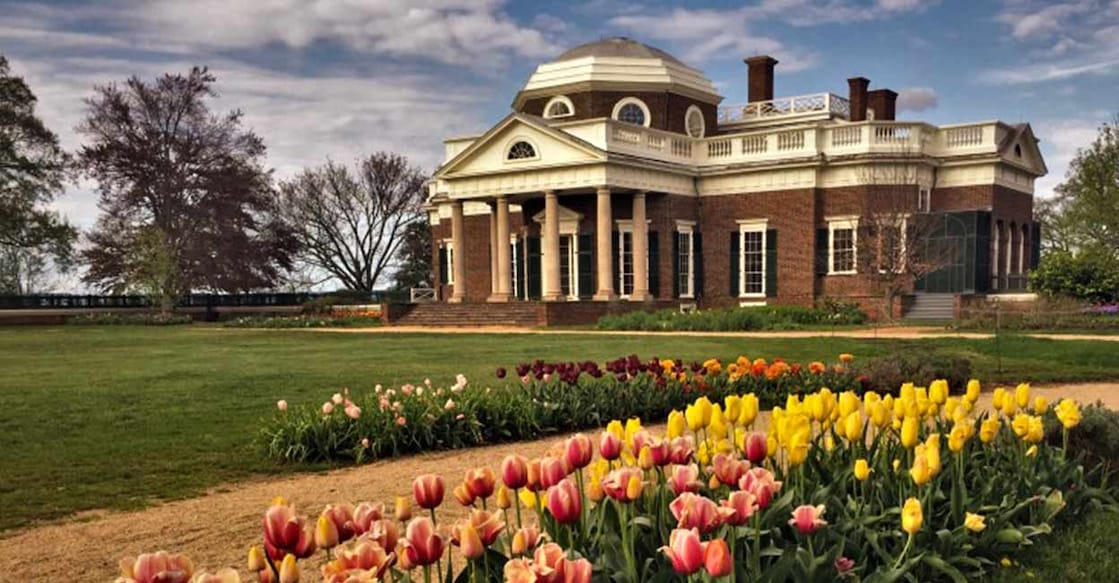Love in the shadows: Thomas Jefferson and Sally Hemings' Monticello saga

Mail This Article
The lush Virginia countryside, with its rolling hills and serene landscapes, hides a story of love, complexity and controversy that has captivated historians and tourists alike for centuries. My recent visit to Monticello, the exquisite estate of America's third President Thomas Jefferson, brought to life the compelling tale of the alleged affair between Jefferson and slave girl Sally Hemings. The Sally story, though long debated, has gained substantial credibility in recent years due to DNA evidence linking Jefferson to Hemings' descendants. On this trip, I had the privilege of meeting one of Hemings' descendants right here at Monticello.
The missing link
As I stand here in the opulent reception halls of Monticello, I can't help but feel a palpable connection to a love story that transcends both the pages of fiction and the annals of history. Now, on this hallowed ground, I await the arrival of Gayle Jessup White, a remarkable individual who carries within her the bloodline of President Thomas Jefferson, passed down through four generations via Sally Hemings.
The anticipation in the air is electric as I await Gayle's arrival, I'm inevitably curious about the narratives she bears with her.
Gayle's tales
Gayle arrived on time. As she entered, it was evident that the African traits in her appearance were less pronounced. Her hair and overall appearance bore a closer resemblance to European features, a reflection of Sally Hemings' own lineage of being born to an English father.

A seasoned journalist and accomplished author, Gayle has gained recognition for her book, 'Reclamation,' and her commitment to research. Currently, she serves as Monticello's Public Relations and Community Engagement Officer. She commenced her career at the New York Times and subsequently ascended as a renowned television reporter and anchor. Gayle has also been prolific in both her writing and public speaking, sharing insights into her impactful work at Monticello.
As we enjoyed a coffee together, our conversation on history steered into the remarkable story of Sally Hemings.
She was renowned not only as the beautiful black wife of one of America's presidents but also as one of the most prominent and famous African women in American history. Despite her mixed heritage and being Jefferson's second wife, Sally was burdened with the status of a slave. Her children and descendants were denied any rights to property and were notably absent from historical records. Gayle artfully illuminated the complex social frameworks of the early 1700s.
We engaged in a thoughtful discussion and explored potential similarities between the experiences of individuals born to mixed parentage, such as a Black person with a white father, and the circumstances of Anglo-Indians. However, Gayle firmly believes that, unlike Anglo-Indians, slaves of any ethnicity never attained a social status higher than that of a slave.
The saga of Sally Hemings
Sally Hemings and Martha, the first wife of Thomas Jefferson, shared a familial connection as half-sisters. They both had John Wayles as their father, who was a prosperous English planter. Sally's mother, Betty Hemings, was of African descent and an enslaved individual. This familial connection extended to five other children within this relationship, among them James Hemings, who achieved renown as a skilled French chef. Later, he assumed the position of Head Chef in Thomas Jefferson's kitchen.

After the death of John Wayles, his father-in-law, Thomas Jefferson came into possession of an extra 135 enslaved people from the Wayles estate. Among this group was Sally. Growing up within the boundaries of the Monticello slave community, Sally garnered a heightened level of attention compared to her contemporaries, primarily due to the influence of her half-sister, Martha.
Sally: The one who remained in bondage
Amid these events, tragedy struck when Jefferson's wife, Martha, passed away. In her absence, Jefferson entrusted the care of his children to his brother and took the role of the United States Minister in Paris. It was during this period that the youngest daughter, Lucy, succumbed to a sudden illness. Faced with this heartbreaking loss, Jefferson decided to take his second daughter, Maria, to Paris to provide her with protection and support. Among those chosen as key aides during this journey were fourteen-year-old Sally. Over time, she became a chambermaid to Jefferson's daughter.

At the age of 44, widowed and seeking companionship, Jefferson found love in the arms of Sally in Paris. During the peak of their relationship, he was prepared to grant Sally her freedom in France. However, Sally made the conscious choice to return home alongside Jefferson. Unfortunately, upon her return, she was bound to the institution of slavery once again, as dictated by Virginia law. Even though she had the opportunity to leave Jefferson and lead a free life in Paris, Sally opted against it. Their love story became a poignant testament to the complexities of affection and choice. Sally remained enslaved for the rest of her life, as did the six children she had with Thomas Jefferson.
The exact nature of Sally Hemings's intimate interactions with Thomas Jefferson will forever remain shrouded in mystery. Enslaved females lacked any legal entitlement to provide consent. Their masters possessed authority over their work, their body and their offspring. The viewpoints held by both Sally Hemings's descendants and historians regarding the relationship between Jefferson and Hemings vary widely, owing to the complex factors of ownership, age, consent, and the starkly imbalanced power dynamic between slaveholders and enslaved women.

A love story shrouded in history
As I strolled through the grandeur of Monticello Estate, it was challenging to reconcile the image of Thomas Jefferson, a statesman and author of the Declaration of Independence, with the man involved in a relationship with a woman who was subjected to enslavement. Visiting Monticello today is a journey through time, a chance to explore the paradoxes of a man who championed freedom and equality but also held more than 600 people in bondage.

The tour guides at Monticello navigate this complex narrative with sensitivity, offering insights into both Jefferson's lustre and the harsh realities of slavery.
Leaving the love story behind, stepping onto the adored grounds of Monticello, I was immediately transported back in time to the era of Jefferson. The first thing that struck me was the breathtaking neoclassical architecture of the mansion, designed by Jefferson himself. As I ventured inside, I couldn't help but marvel at the intellect and ingenuity of this remarkable man. The library, adorned with countless volumes, seemed to whisper the stories of Jefferson's curious mind and insatiable thirst for knowledge.
Mulberry row: Stories of enslaved lives
Exploring the lush lawns, gardens and orchards, I was struck by his deep appreciation for nature and agriculture, which he diligently documented in his 'Garden Book'. The serenity of the landscape was a testament to his vision for harmonious living with the land. Descending into the cellar, I was reminded of Jefferson's role as an inventor. The wine cellar, equipped with a small freight elevator, showcased his ingenious solutions for everyday challenges. Monticello was a self-sustaining estate that produced its food, including meat, vegetables, and even alcohol. The property had its skilled craftsmen, ranging from carpenters and tailors to blacksmiths.

Yet, it was the Mulberry Row, where enslaved individuals lived and worked, that brought forth the complexities of Jefferson's legacy. The stories of those who toiled here were a stark reminder of the contradictions inherent in Jefferson's life. People who lived and worked on Mulberry Row played a central role in the daily operations of Monticello. They were responsible for a wide range of tasks, from gardening and farming to carpentry and household chores. Their toiling was essential to the functioning of the plantation and the maintenance of Jefferson's comfortable lifestyle.
It's intriguing to observe that, in contrast to others who slept in bunk beds and shared quarters, both Sally and her brother, French Chef James, were afforded distinctive single accommodations in the basement of the bungalow. It's evident that during that era, there existed varying hierarchies among enslaved individuals, with certain roles like chamber maids and chefs receiving preferential treatment. In many instances, those favoured roles were held by people who were of mixed race, often born to a white father.

Exploring Monticello's complex legacy
My visit to Monticello left me with mixed emotions. It's a place where history is neither entirely black nor white but exists in shades of grey. It reminds us that historical figures, even those like Thomas Jefferson, were complex human beings with both admirable qualities and flaws.

This travelogue would be incomplete without highlighting a remarkable distinction between Jefferson and a typical Indian politician.
Despite being born a billionaire, Jefferson was nearly bankrupt by the time of his passing. His cherished possessions, including Monticello, were sold by his daughter for survival. Most of his wealth was dedicated to national causes, notably the founding of the University of Virginia.
When in Washington, D.C., be sure to seize the opportunity to explore Monticello. You can acquire tickets at www.monticello.org, with prices starting at $32. Monticello warmly welcomes nearly half a million visitors annually. Indeed, let us express our heartfelt gratitude to the Thomas Jefferson Foundation for their dedicated efforts in preserving this extraordinary estate.


